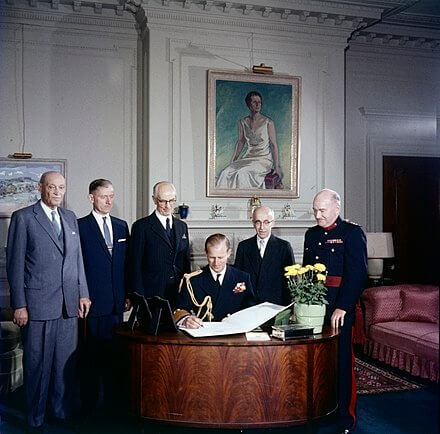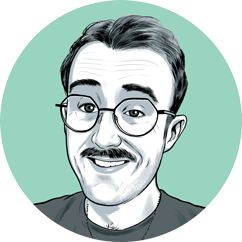
Charles Perry Stacey. [Wikimedia]
Born and raised in Toronto, Charles Perry Stacey—better known as C.P. Stacey—showcased a passion for history from an early age. It was destined to be the same passion he would carry forth into his later professional life.
Between 1933 and 1940, Stacey, an academic working at Princeton University, put pen to paper. The resulting publications would garner considerable unanticipated attention.
“He was one of the very few people during the 1930s who was writing about military history and defence in Canada,” explains the Canadian War Museum’s chief historian and acclaimed author Tim Cook, whose titles include Clio’s Warriors: Canadian Historians and the Writing of the World Wars.
In 1940, Stacey published The Military Problems of Canada, a short yet perceptive insight into Canadian defence policies and strategic conditions. It was, suffice to say, a timely account so soon after the outbreak of war.
With Canada’s military preparedness—or perceived lack thereof—at the forefront of minds, a newly promoted Major-General Harry Crerar, future commander of First Canadian Army, sought out Stacey’s credentials.
By then operating out of the U.K.-based Canadian Military Headquarters (CMHQ), Crerar wanted an officer and qualified historian to “supervise [the] preparation of War Diaries and [the] collecting of other historical data.”
Crerar, in other words, wanted someone to document Canada’s role in what already appeared to be the defining moment of the century, perhaps beyond.
The 34-year-old professor, already an astute chronicler with experience in the Canadian militia, seemed like the perfect candidate. Stacey eventually found himself at CMHQ sharing the same halls as Canada’s top military brass.
There, Cook notes, Stacey had the advantage of close contact with the shapers of Canada’s Second World War experience. His superiors, meanwhile, understood the value of history and their place in it. This would help open many otherwise tightly locked doors.
“Stacey received access to the sort of records that any historian would salivate over,” suggests Cook. “He was given considerable freedom to carry out his assigned tasks. Now, there were others involved, but his role meant that he was part of the process of writing draft histories over the course of the war.”

Prince Philip, visiting the Royal Society of Canada, surrounded by Dr. Charles Camsell (left), Dr. Loris Shano Russell, Dr. T.W.N. Cameron, Leon Marion and Colonel C.P. Stacey in 1957. [Wikimedia[
“Think of Dieppe, for instance,” Cook continues. “[Stacey] is not even alerted to 1942’s Operation Jubilee due to secrecy issues. He is then asked to in effect whitewash and justify Dieppe, which he struggles to do. But he does write something that’s still critical enough for Mountbatten [a member of the Royal Family and British planner of the raid] to almost accuse him of treason.”
Walking a tightrope between accurately portraying events and avoiding the embarrassment of Canadian military authorities, Stacey persevered in recounting the recent past with one eye on a not-too-distant future.
“He was immersed in the history, immersed in the records, talking to generals, and sending historical officers and war artists out into the field,” says Cook. “This created the foundation after the war to begin writing a full narrative.”
In the face of postwar retrenchment and shrinking budgets, two of the three official histories, specifically those focusing on Canada’s air and naval arms, withered in the face of severe budgetary cuts. Only the Canadian Army program entrusted to then-Colonel C.P. Stacey appeared to survive the initial cull.
Nevertheless, there remained an uphill struggle in passing judgment on Canada’s victories and defeats, a “heavy responsibility” that Stacey recognized as “in some respects an unpleasant job.” Harnessing a sense of duty while acknowledging the importance of posterity, he worked with a small team of historians and waded through millions of pages of documentation.
The first fruits of their labour became apparent in 1948, when Stacey published his one-volume summary titled The Canadian Army, 1939-1945. Though arguably vague in some areas—partly, if not completely, the result of negligible access to British war records—the book proved accessible to all Canadians.
The Legionary, as today’s Legion Magazine was known at the time, described the official historian’s bestseller as a “masterful study of care and precision, a monument worthy of the brave men [and women] whose deeds it records.”
Stacey intended to write a multi-volume official history that would delve deep into the Canadian Army, but further obstacles awaited him. Subsequent delays and red tape, compounded by politicians’ apparent fears of revealing inconvenient truths, came exceedingly close to prompting his resignation.
The most significant criticism is how he characterized the fighting in Normandy
Despite frustration at the government’s apathy, Stacey managed to publish Six Years of War: The Army in Canada, Britain and the Pacific in 1955. The following year, in 1956, his Directorate of History released G.W.L. Nicholson’s The Canadians in Italy, 1943-1945. Finally, in 1960, The Victory Campaign: The Operations in Northwest Europe, 1944-1945, entered the public domain.
While each book contained passages that would warrant historiographical debate over the ensuing years and decades, it was Stacey’s last volume that seemed to court the most controversy, at least in its immediate wake.
Cook explains: “The most significant criticism is how he characterized the fighting in Normandy, where he wrote that the Canadians, while brave and fighting effectively, were sometimes too cautious. In later years, Stacey insisted that his remarks did not obscure the incredible success of the Canadians in battle. He also said that if the British and Americans had been honest in their respective official histories, they would have had the same criticisms.”
Further scrutiny of Stacey’s works, even after his death in 1989 at age 83, continues. But, few argue his place in Canadian military history.
“Some see official histories—wrongly, I would suggest—as the last word,” says Cook. “In Stacey’s case, they were the first word. Almost nothing before him had been published. His books thus allow the rest of us to go back and reassess them. No historian—myself included—could do anything without him.”
Advertisement






















